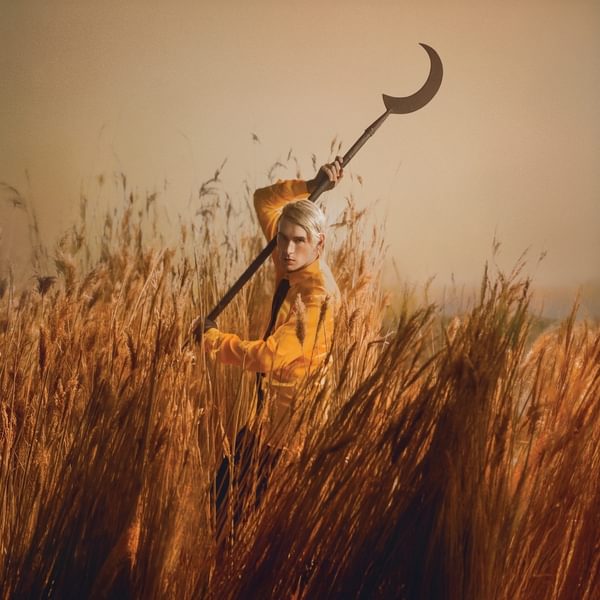Various Artists - C86
"C86"

But then, it was never intended to create a scene or make stars of its bigger hitters. Indeed, C86‘s very existence might have just been to wind up journalist and fashionista Paolo Hewitt. The original NME release, a successor in name to the more scattershot post-punk snapshot of five years earlier C81, but also merely the latest of twenty-three mail ordered cassettes, was ostensibly intended as a summation of some of the new sounds from the emerging independent sphere, paying as much interest to labels doing interesting things out of back bedrooms as much as those already shouting loudest. Within the offices at King’s Reach Tower, however, the weekly’s staff were embroiled in what became known as ‘the hip-hop wars’, writers split between those who saw the paper’s future only in embracing the new hip-hop and soul sounds coming out of black America and those who saw a better future in sticking with the guitar blueprint that had seen them help make The Smiths and The Jesus and Mary Chain national talking points in the previous few years.
That schism and its attendant editorial confusion ended up with a completely confused editorial policy. Black artists were represented on twelve of 1986’s 51 covers but most consumers still weren’t going near magazines with those on the cover. Regardless the likes of Trouble Funk, Courtney Pine, a piece about rap culture entitled The Yo Boys and a Hewitt polemic headed “Why British black music has no chance” - rubbed shoulders with new guitar bands (Sonic Youth, the Mighty Lemon Drops, Easterhouse), leftfield selections very much of their time (Dwight Yoakam, W.A.S.P. and the PMRC’s attitude to metal, a ‘Youth Suicide’ issue with an almost entirely black cover) and, perhaps in recognition of the impact The Face was about to make in the lifestyle magazine sphere, some non-musical figures (Barry McGuigan, Daley Thompson, pre-pop Samantha Fox). By early 1987 the paper’s circulation had fallen below 100,000 a week for the first time.
Taken out of its sociological context, C86 can seem adrift. Often dismissed as naive and wilfully amateurish, while it documented a fast moving and spirited series of movements as one whole, to a wider audience it was before too long boiled down to an audio-visual cliche involving groups of pale, fey youths sporting polka-dot shirts and bowl haircuts playing Byrds riffs on Rickenbackers. The wider context, however, is one that has been sporadically brought back over the last decade or so, partially through compilations like 2012’s Scared To Get Happy box set and the 2006, Bob Stanley-curated CD86, with its traces seeping through into the likes of The Pains Of Being Pure At Heart, Joanna Gruesome and Vivian Girls, not to mention a strong international network of supportive labels, distributors and promoters. The original cast were essentially godchildren of the DIY punks, occasionally openly left-wing politicised, female friendly and often genuinely emerging from a vibrant grass roots scene of swapped tapes and writings, celebrating the moment. Stanley has called it the birth of indie as we came to know it, for all that would come to entail; Kurt Cobain was a known follower of C86-derived bands; C86 admirer Nicky Wire has mused approvingly on the way it involved “people… doing everything themselves: making their own records, doing the artwork, gluing the sleeves together, releasing them and sending them out, writing fanzines because the music press lost interest really quickly.” Some may take its whitebread nature and link it to the smooth, stylised nature of modern ‘indie’, but in truth such bands were pitching themselves against the corporate entities of the day, showing that there was another way.
Enough of all that, what about the album? Reissued properly for the first time by Cherry Red Records, the much admired indie who were there at the time (their 1982 compilation Pillows & Prayers is in many ways a key influence on C86), it’s been given a grand presentation incorporating novella-length liner notes by Neil Taylor, who with Roy Carr and Adrian Thrills compiled the original line-up.
That C86 has been reduced to so specific an image, usually for mockery purposes, in the popular imagination doesn’t mean it’s always incorrect. There’s still plenty of jangle for your buck, right from the first track. While modern Primal Scream like to pretend Screamadelica was their Year Zero, before then Bobby Gillespie and Andrew Innes had been… well, pale, fey youths sporting polka-dot shirts and bowl haircuts whose 82-second “Velocity Girl” is based around Byrds riffs played on Rickenbackers. At this point they sound like the sort of band who would disappear and be the subject of a very minor cult years later, which is why we should never underestimate Andrew Weatherall.
That ‘janglepop’ sound, derived from the Postcard Records ‘Sound Of Young Scotland’ of Orange Juice and Josef K with nods to the charm of the Television Personalities and the punk rush of Buzzcocks (both of these among the first significant bands to go DIY with their releases), is usually exhilirating and vital in small doses such as the two or three minute rushes here, but it’s usually not something strong enough to build a career around. That’s not to say there aren’t some that do it much better than others. The Bodines were widely tipped for big things but dissipated, not before delivering in “Therese” a cocksure stomp that borrows a near-Motown drumbeat and overlays it with overlapping miniature guitar solos that try to outdo each other for ambitious overreaching. The Wolfhounds, whose “Feeling So Strange Again” also clocks in at comfortably under two minutes, possess a pleasingly askew sense of melody and have the foresight to cut the song off before reaching a middle eight or final chorus. The Wedding Present get the closing spot, “This Boy Can Wait” laying down the hypersonic jangle and David Gedge as lovelorn poet template that would serve them well and from which they would develop swooning claws.
A listen to the original document, though, suggests infamy has attached itself to some bands who really wouldn’t thank anyone for being bracketed together with the developing likes of The Pastels. Mighty Mighty play with propulsive Afropop influences, We’ve Got A Fuzzbox and We’re Gonna Use It!! (who would years later turn unashamedly glossy pop and gain a couple of big hits out of it) sound in the space of 84 seconds like the B-52s in a state school cupboard, while The Shop Assistants tone down their usual feedback roar for a muted, ringing melancholia recalling The Velvet Underground and Young Marble Giants. John Peel coined the term ‘shambling’ to describe Bogshed, whose “Run To The Temple” sounds like an English suburban take on Devo’s robot anti-rock. Age Of Chance, who would soon embrace early house beats and nearly chart with a cover of Prince’s “Kiss”, have the driving, distorted dirty sound and relentless thump of industrial noise.
Four tracks came from the glamorously named Ron Johnson Records, run out of a kitchen in Long Eaton and specialising in jagged, seemingly semi-damaged bands indebted to Captain Beefheart, the Fall and no-wave’s jazz influence. Even in the context of The Mackenzies, The Shrubs and Big Flame sounding like they’re constantly tripping up over each other, “Buffalo” by Stump still sounds extraordinary and singular, a bass part that sounds like it’s being detuned mid-pluck just about holding things together under Mick Lynch’s non-sequitur fridge poetry (“HOW DO I GET OFF THE BUS?”) Stump ended up on a major label, perhaps by accident. And how would you pigeonhole Half Man Half Biscuit and their straightforwardly title “I Hate Nerys Hughes (From The Heart)”?
As barely anyone is satisfied with the original product as presented these days, this C86 is a deluxe edition featuring two extra discs of contemporaries and related rarities of varying fidelity. If these do seem slightly heavier than the original record on effort over true invention, it does fill in some useful gaps in the C86 timeline.
The June Brides, who had appeared on the NME cover in September 1985, had refused to appear on the tape for fear of typecasting; “Just The Same” is a semi-official relenting, if not a particularly standout one except for working in Bacharach-inspired strings and trumpet. Talulah Gosh, the very essence of twee-dom to a lot of people, were surprisingly left out, “I Told You So” elevated to the pantheon as it finds them hanging on to the edge of their ability. The Jesus & Mary Chain themselves were left out as they had just signed to WEA but their significance in the scene and how it got to where it had ended up makes their inclusion inevitable, “Inside Me” a classic example of Psychocandy‘s mix of fatalism and feedback, several of whose adherents turn up on the third CD. The Happy Mondays’ Bernard Sumner-produced second single “Freaky Dancin’” is a prime example of their way of throwing everything at the wall and watching more than expected stick, as a tribal rhythm, Sly Stone wah-wah guitar and acoustic folk rhythm rubs up uncomfortably against Shaun Ryder off on one as ever. The Primitives and The Railway Children would later polish up and have hits, as would Treebound Story guitarist Richard Hawley and half of particular Cobain favourites BMX Bandits with Teenage Fanclub. As always it’s hard to think that Pop Will Eat Itself, here in their scrappy early incarnation before discovering sampling and hip-hop, led directly to Clint Mansell’s soundtracker to the stars status.
That trebly guitars sound keeps recurring at varying levels of charm, the Jasmine Minks standing out in such company, and paths were being carved away from such settings; Pete Astor, who had fronted recent influence The Loft, developed a more streamlined sound in The Weather Prophets, while the cabaret sophistication of the Band Of Holy Joy found its niche a few years later. This writer was previously unaware of Lawrence & The Comfortable Society - who released one single and, it inevitably turns out, didn’t have a member called Lawrence - but their “Heartache” is an elegantly soulful standout. Similarly the unpromisingly named North Of Cornwallis, who often toured with the Housemartins and whose singer Lester Noel ended up joining Norman Cook in Beats International, sound ready for summer daydreaming. On a different tack The Membranes, the first musical outlet for the infamous John Robb, find a common ground between speedy jangle and a post-punk industrial backbeat that sounds like Siouxsie’s Banshees have broken free and which seems to have influenced Steve Albini’s Big Black. Similarly Pigbros’ warp factor clanging guitar sound and bass-heavy rumbling, “Hedonist Hat” climaxing with sax skronking to boot, is much darker and enveloping than most. The Noseflutes, for their part, incorporate a percussion solo seemingly played on anything to hand into a more noisily ragged sound than most.
C86, as in the original cassette, turned out to be a means to an end. Things got bogged down in debate about what it all meant, a handful of bands got signed to bigger labels for a year or two, some of the labels (including Ron Johnson Records) were lost to financial collapse, and then house music arrived and cleared the cultural decks. Having ridden out the best part of a couple of decades, C86 and its associated scene re-emerges with a great deal of credit. While it may not be the sort of set to listen through all three CDs back to back, such are the number of bands cleaving to one or other recent influence in their style of guitar playing (and feeding back), there’s more than enough evidence that for reputation alone it’s hard done by and there’s a lot more in the way of inventive approaches, strong songwriting and force of personality here than one might have been led to believe.
Get the Best Fit take on the week in music direct to your inbox every Friday

Patrick Wolf
Crying The Neck







